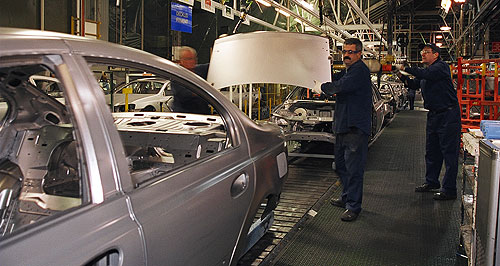Make / Model Search
News - FordFord production to fall to 80 cars a daySlowing down: Ford’s build rate at its Broadmeadows plant was 450 cars a day in 2006 – until it announced in October that year that it was cutting 20 per cent from this. From June 2014, the daily line rate will be down to 80-90 cars. Line rate for Ford’s Broadmeadows plant to drop to as low as 80 cars a day from June14 Feb 2014 By TERRY MARTIN FORD will cut the line rate at its Broadmeadows assembly plant in Victoria to as low as 80 vehicles a day in June as the company continues to realign production to the dwindling demand for its Australian-built vehicles. Ford Australia has told GoAuto that the line rate will be reduced to between 80 and 90 vehicles a day at the factory, having already cut back its output in January to 133 cars a day while at the same time shifting some of its workforce onto its new-model programs. Last year, the company was producing cars at a rate of 149 vehicles a day, which is the level set in November 2012 when the company pulled back from 209 cars a day and reduced its workforce by 330, most of which were forced redundancies. Only eight years ago, the build rate at Broadmeadows was 450 cars a day – or 65 cars an hour – but it has been spiralling downward since then. As previously reported, this latest action comes at a cost of another 300 jobs, cutting the payroll numbers at the company’s major sites at Broadmeadows and Geelong to about 700. Although January sales are notoriously slow, both the Falcon sedan and Territory SUV fell 41 per cent last month, to just 461 and 681 units respectively, while 237 new Falcon utilities were registered. Last year, Ford sold only 10,610 Falcon sedans, down 24 per cent on 2012, the ute was below 5000 units on 4679 (down 18 per cent) and Territory managed 14,261 sales (down 3 per cent). All up, sales across the three model lines totalled less than 30,000 units. Ford Australia communications and public affairs director Wes Sherwood said February sales were continuing to reflect weak demand for the large vehicles the company produces. However, he would not be drawn on whether the adjusted line rate of 80 vehicles a day was as low as the company could manage, potentially forcing it to close down its manufacturing operations earlier than the planned shutdown in October 2016. “We’re not really getting into details of our manufacturing plans,” he said. “We plan to manufacture our vehicles until October 2016 – that is still our plan – but if there are some sort of major disruptions across our operations or something in the market, then we may have to go back and re-evaluate our plans. “Our focus, really, is to help ensure an orderly transition in the industry – for our employees, for our suppliers – so that’s really where we’re focused on. Obviously, there are manufacturing implications, but in terms of what our focus is on, we’re trying to do what’s right for the industry and our employees.” Mr Sherwood would not comment on the extent to which Ford’s parts suppliers remained viable over the next two years, especially in the wake of Toyota’s announcement this week that it was following Holden in shutting down its factories here in 2017. However, he said Ford Australia would continue to work with its supply chain to help ensure supplies continued until 2016. “Really, what we are looking for is as smooth a transition as possible, understanding that there are going to be difficulties and watching for any major disruptions,” he said. “As part of helping ensure an orderly transition for the entire industry, a key part of that is working with the suppliers to make sure they can support our intent to manufacture through October 2016. “I don’t want to get into characterising our ongoing discussions, but that is the focus of what we talk to them about.” In terms of the pressure now ramping up on all three car-makers, with calls this week for import tariffs to be removed and taxpayer funding received in recent years to be handed back, Mr Sherwood said Ford was a different case to Toyota and Holden in that it would still have a significant workforce in Australia after it closed down its manufacturing operations. “The thing we’re trying to emphasise is that Ford is actually different,” he said. “We have, and plan to still have, a significant engineering and design ... operations base into the future. “In fact, assuming all the actions that have been announced take place (with Toyota and Holden), we will be Australia’s largest employer for the type of highly skilled engineering and design jobs of which we have approximately 1000 of those. “So our emphasis is really on helping the public understand that difference because we are absolutely committed to this market and we think, unfortunately, people are discussing it as if the companies are all in the same situation when, in fact, we’re not.”  Read more12th of February 2014  Dump vehicle tariffs, say motoring clubsEnd the tariff price pain for car buyers, AAA tells federal government11th of February 2014  Parts industry: “It’s a bloody disaster”Components industry may not even be able to supply car-makers out to 201710th of February 2014  Toyota quits: Local industry ‘will never be the same’Federal, state leaders vow to help workers facing axe as political blame game begins10th of February 2014  Toyota quits: Australia to lose car-making in 2017Toyota Australia’s hand forced as Ford, Holden also prepare for exit |
Click to shareFord articlesResearch Ford Motor industry news |











Facebook Twitter Instagram